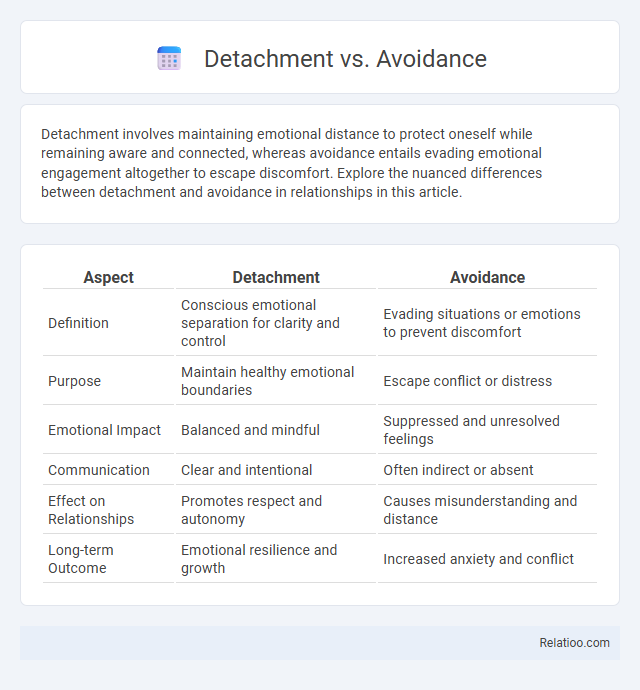Detachment involves maintaining emotional distance to protect oneself while remaining aware and connected, whereas avoidance entails evading emotional engagement altogether to escape discomfort. Explore the nuanced differences between detachment and avoidance in relationships in this article.
Table of Comparison
| Aspect | Detachment | Avoidance |
|---|---|---|
| Definition | Conscious emotional separation for clarity and control | Evading situations or emotions to prevent discomfort |
| Purpose | Maintain healthy emotional boundaries | Escape conflict or distress |
| Emotional Impact | Balanced and mindful | Suppressed and unresolved feelings |
| Communication | Clear and intentional | Often indirect or absent |
| Effect on Relationships | Promotes respect and autonomy | Causes misunderstanding and distance |
| Long-term Outcome | Emotional resilience and growth | Increased anxiety and conflict |
Understanding Detachment and Avoidance
Understanding detachment involves recognizing a healthy emotional boundary where you maintain inner calm without suppressing feelings, while avoidance entails evading emotions or situations that cause discomfort, leading to unresolved issues. Detachment allows for objective perspective and balanced responses, whereas avoidance often results in increased stress and anxiety due to unaddressed problems. Cultivating detachment helps your mental resilience by accepting reality without becoming overwhelmed, unlike avoidance which disrupts emotional processing.
Key Differences Between Detachment and Avoidance
Detachment involves maintaining emotional balance by accepting situations without overinvolvement, whereas avoidance means actively evading uncomfortable feelings or realities, often leading to unresolved issues. Detachment allows you to experience emotions without being controlled by them, promoting clarity and resilience, while avoidance creates a barrier that can hinder personal growth and problem-solving. Understanding these key differences helps you develop healthier coping strategies and emotional intelligence.
Psychological Foundations of Detachment
Psychological foundations of detachment involve maintaining emotional equilibrium by observing experiences without becoming overwhelmed, which contrasts with avoidance that entails evading uncomfortable feelings or situations. Detachment allows you to respond thoughtfully rather than react impulsively, fostering resilience and mental clarity. Unlike avoidance, true detachment supports healthy boundaries and emotional regulation, essential for psychological well-being.
Psychological Roots of Avoidance
Avoidance stems from deep psychological roots such as fear of pain, anxiety, and unresolved trauma, driving individuals to evade discomfort or perceived threats. Detachment involves emotional distancing to maintain inner stability without necessarily escaping reality, whereas avoidance actively attempts to bypass distressing experiences. Understanding these distinctions aids in addressing maladaptive coping strategies linked to stress and mental health disorders.
Signs of Healthy Detachment
Healthy detachment involves recognizing your emotions without becoming overwhelmed or disconnected from reality, allowing you to maintain balance and clarity in challenging situations. Signs of healthy detachment include staying calm under stress, setting clear boundaries, and responding thoughtfully instead of reacting impulsively. Your ability to observe experiences objectively while remaining emotionally present differentiates healthy detachment from avoidance or unhealthy detachment.
Traits of Avoidant Behavior
Avoidant behavior is characterized by a persistent pattern of evading social interactions, emotional closeness, and situations perceived as stressful or threatening, often driven by fear of rejection or criticism. Individuals exhibiting avoidant traits frequently demonstrate low self-esteem, heightened sensitivity to negative evaluation, and a strong preference for isolation to maintain emotional safety. This behavior contrasts with detachment, which involves emotional withdrawal without necessarily fearing interaction, highlighting avoidance as an active defense mechanism rooted in anxiety and self-protection.
Impacts on Relationships: Detachment vs Avoidance
Detachment in relationships often involves a healthy emotional boundary that allows individuals to maintain personal well-being without excessive dependence or conflict, fostering stability and mutual respect. Avoidance, however, typically leads to unresolved issues and emotional distance due to evading conversations or feelings, which can weaken trust and intimacy. Understanding the difference between detachment and avoidance is crucial for sustaining effective communication and emotional connection in partnerships.
Emotional Well-being: Which Approach Serves You?
Detachment involves maintaining emotional boundaries to protect your well-being without suppressing feelings, whereas avoidance often leads to unresolved emotions and increased stress. Practicing healthy detachment allows you to acknowledge emotions objectively, promoting resilience and mental clarity. Your emotional well-being thrives when you balance engagement with emotional challenges and strategic distance.
Transforming Avoidance into Mindful Detachment
Transforming avoidance into mindful detachment involves recognizing and addressing emotions without suppressing or evading them, promoting healthy emotional regulation. Unlike avoidance, which often leads to unresolved stress and anxiety, mindful detachment encourages awareness and acceptance of experiences with non-reactive observation. This practice enhances psychological resilience by fostering a balanced perspective that reduces emotional reactivity and supports conscious decision-making.
Practical Strategies for Healthy Emotional Balance
Detachment involves observing emotions without becoming overwhelmed, enabling clear decision-making and reducing impulsive reactions. Avoidance often leads to unresolved feelings and increased stress by ignoring or suppressing emotions rather than addressing them. Practicing healthy emotional balance includes mindfulness techniques, setting boundaries, and engaging in self-reflection to cultivate detachment while preventing avoidance, promoting resilience and emotional well-being.

Infographic: Detachment vs Avoidance
 relatioo.com
relatioo.com